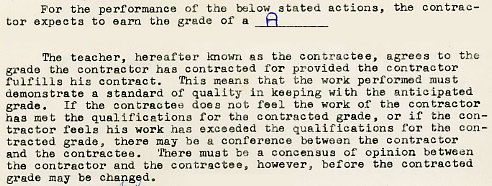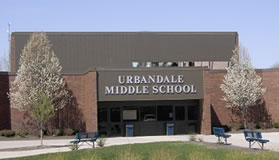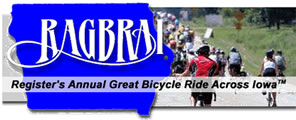Annie in Middle School: 1971-1973
 It's the early 1970s and Annie is attending a new middle school with an educational philosophy focusing on interdisciplinary approaches to learning.
It's the early 1970s and Annie is attending a new middle school with an educational philosophy focusing on interdisciplinary approaches to learning.
With the recent moon landing on July 20, 1969, Annette's interest in space exploration is at a high. Seeing Neil Armstrong's first steps on the moon kept Annette glued to the television and closely following the space program.
Click the photo and choose a NASA moon landing video to watch.
 Annette's a huge fan of the Star Trek television series and sees it as a forum for discussion of social issues from race relations to environment issues. Models of the starships hang from her bedroom ceiling. She listens to the music of the movie 2001: A Space Odyssey and imagines the future. Her reading is expanding into many areas including science fiction. She's fascinated by how science fiction reflects social issues.
Annette's a huge fan of the Star Trek television series and sees it as a forum for discussion of social issues from race relations to environment issues. Models of the starships hang from her bedroom ceiling. She listens to the music of the movie 2001: A Space Odyssey and imagines the future. Her reading is expanding into many areas including science fiction. She's fascinated by how science fiction reflects social issues.
Passage of the National Environmental Policy Act (1970), Clean Air Act (1970), and Clean Water Act (1972) has again focused Annie's attention on environmental issues. The first graduating class of the new middle school is planning to plant trees in the school yard in the spring.
Questioning & Exploration
In 1971, the Keep America Beautiful campaign launched another public service announcement. This time featuring Chief Iron Eyes Cody and the tag line, "People Start Pollution. People can stop it." The focus on citizens taking action struck a chord with Annie. She jotted down the address shown at the end of the commercial (99 Park Avenue, New York, New York) and wrote a letter requesting the brochure "71 Things You Can Do To Stop Pollution." The brochure indicated that anyone could become a community volunteer and encouraged people to get involved with Earth Day. She learned that Earth Day was established by Senator Gaylord Nelson of Wisconsin on April 22, 1970.
Click the still image from the PSA (above) to learn more about this campaign and view the video.
Annie began to think about her renewed interest in environmental concerns and jotted down these questions:
- What do these "acts" actually say?
- Will these new laws have a positive impact on the environment?
- What is our community doing to address these issues?
- What can a middle school student do to make a difference?
Annie scheduled a conference to talk to her teacher about ideas for a project related to these topics. The instructional specialist agreed that these questions matched the requirements of a required interdisciplinary project. She asked Annie to learn more about the options before committing to specific end products. They signed an educational contract with the provision that specific products and criteria be added later (see the contract below).

After Annie's experiences becoming overwhelmed with past projects, she has learned to divide her activities into manageable chunks. Annie decides to break her project into three areas: the acts themselves, local government action, and local citizen action.
Annie's first stop is the public library. She felt confident in her general knowledge of the environmental movement, so she didn't spend time exploring secondary sources for background information. She wasn't interested in reading popular magazine articles about the acts, she wanted to read the primary source documents so she skimmed the acts in the Congressional Record. Annie was a little frustrated by all the legal jargon, but she noted the points she thought were most relevant to her local community.
 Annie's father is Deputy Commissioner of Social Services for the State of Iowa. He's also involved in local community activities such as the Parks and Recreation program and even coaches Annie's softball team, the Wrens. He suggests that Annie interview some local government officials about the environmental movement in their community.
Annie's father is Deputy Commissioner of Social Services for the State of Iowa. He's also involved in local community activities such as the Parks and Recreation program and even coaches Annie's softball team, the Wrens. He suggests that Annie interview some local government officials about the environmental movement in their community.
Annie began to brainstorm questions she'd like to ask local government officials. However, she wasn't really sure what government officials would be able to answer questions, so she decided to ask the school media specialist. When Annie described her project, the instructional specialist was excited to become involved. She showed Annie a notebook containing information about the local government structure, names, and phone numbers. In addition, the media specialist suggested that Annie check out an audio recorder to tape the interview. She even gave Annie a handout containing "ten tips for conducting great interviews."
After calling the City Manager's office, Annie was able to schedule an appointment to interview the City Manager as well as a City Council member who was particularly interested in environmental issues. Annie's mother agreed to drive her to the office and provide encouragement. Although Annie was very nervous about the interviews, everything went fine. She never realized how much was involved in running a small city and how many priorities compete for attention. Fortunately, the people she interviewed were well informed and were able to answer most of her questions.
Although Annie was convinced that the local government officials were aware of the implications of the acts, she was less sure of the general public. She decided to do a quick survey to find out how much community members knew about this legislation. She created a short survey with five questions and recruited three of her friends to help her conduct the survey during intermission at the high school basketball game. Since the survey simply involved checking boxes, it was easy to tabulate and analyze. Annie was happy to find that most people had seen the Keep America Beautiful PSA on television and indicated they thought saving the environment was important. However she was disappointed to find that many people weren't aware of the new acts and did very little to save the environment themselves.
Assimilation & Inference
After gathering so much information, Annie decided to spend a weekend organizing and analyzing her materials. Although she felt the city was on track and the general public was aware of the issues, she was disappointed that most people didn't share her passion and commitment to action. She was also concerned that many people weren't aware of the key issues presented in the acts or how they could take action.
Annie decided that the best course of action was to write a letter to the editor providing an overview of the key features of the acts and what every day people could do in the local community. Drawing on ideas from the Keep America Beautiful and suggestions from the local government officials she encouraged people to become involved in local Earth Day activities. Annie carefully quoted the City Manager and City Council member. Before submitting the article, she phoned the City Council member to double-check the quote she planned to use. The Council member was happy to hear about the article and even called a friend at the local newspaper to let them know the article was coming. Annie doesn't know whether it was the Council member's phone call or the quality of her letter that convinced the paper to print her article. However she was thrilled to see her writing published.
 In August of 1973 the Des Moines Register's sponsored the first RAGBRAI, the Register's Annual Great Bicycle Ride Across Iowa. Annette decided to raise awareness of the environmental movement by biking a segment of the ride (photo on left, front bike). The bike ride brought attention riding bikes rather than cars to save gas. Since that time, RAGBRAI has become the longest, largest and oldest bicycle touring event in the world.
In August of 1973 the Des Moines Register's sponsored the first RAGBRAI, the Register's Annual Great Bicycle Ride Across Iowa. Annette decided to raise awareness of the environmental movement by biking a segment of the ride (photo on left, front bike). The bike ride brought attention riding bikes rather than cars to save gas. Since that time, RAGBRAI has become the longest, largest and oldest bicycle touring event in the world.
Click the RAGBRAI visual to learn more about this popular bike ride.
Reflection
Annie is continuing to grow as a student information scientist.
Skills and Scaffolding. While she once relied primarily on sources such as encyclopedias and nonfiction books for information, she increasingly seeks a variety of resources including primary source documents.
Strategies. Annie is beginning to develop her own style of investigation. For example she's found that dividing her projects into smaller chunks makes them more manageable.
Realization. Annie is growing more confident in asking others for assistance. She recognizes that each person has a unique set of knowledge and skills that can be helpful in different situations.
Standards
Information Literacy Standards Indicators (Selected from Information Power, AASL, 1998)
- Develops and uses successful strategies for locating information.
- Applies knowledge to critical thinking and problem solving.
- Produces and communicates information and ideas in appropriate formats.
- Assesses the quality of the process and products of personal information seeking.
- Respects the principle of equitable access to information.
- Shares knowledge and information with others.
Indiana Content Standards
- Recognize and explain that when similar investigations give different results, the scientific challenge is to judge whether the differences are trivial or significant, which often takes further studies to decide (7).
- Explain why it is important in science to keep honest, clear, accurate records (7).
- Describe that different explanations can be given for the same evidence, and it is not always possible to tell which one is correct without further inquiry (7).
- Explain how engineers, architects, and others who engage in design and technology use scientific knowledge to solve practical problems (7).
- Explain that technology often have drawbacks a well as benefits (7).
- Explain how societies influence what types of technology are developed in used (7).
- Explain that the environment may contain dangerous levels of substances that are harmful to human beings (7).
- Explain that humans help shape the future by generating knowledge, developing new technologies, and communicating ideas to others (8).
- Participate in group discussions on scientific topics by restating or summarizing accurately what others have said, asking for clarification or elaboration, and expressing alternative positions (8).
- Explain that the atmosphere and the oceans have a limited capacity to absorb wastes and recycle materials naturally (8).
- Recognize and describe important environmental legislation such as the Clear Air and Water Act (Environmental Science).
- Understand that as a result of Silent Spring, there are now hundreds of national, state, and local laws that regulate pesticides (Environmental Science).
- Distinguish between the different functions of national and state government within the federal system (8).
- Examine various social influences that can lead to immediate and long-term changes (Sociology).
Times Have Changed
Many resources that have been difficult to locate in the past are now available electronically. For example, some primary sources documents can be found online. This provides a unique opportunity for students to read the original text of laws, transcripts from court cases, and explore raw data sources. For example, the Congressional Record contains the official record of the proceedings and debates of the United States Congress and is published daily.
Many government documents are available. For example, you can read the following US Acts: National Environmental Policy Act of 1969, Clean Air Act (1970, 1990), Clean Water Act (1972, 1977, 2002), and The Endangered Species Act of 1973.
A number of today's technologies would have been helpful for this project. For example, digital technology would provide even more choices in recording the interview of community officials. For example, a small MP3 recorder or camcorder could be used to increase ease of data storage and editing. These could then be integrated into a multimedia presentation or streamed online.
Using a hand-held device could have reduced the paperwork and data collection time involved with Annie's survey.
Finally, a website or blog could be used to keep interested member of the community up-to-date on changing news and information.
 Update
Update
Thirty years later students at UMS are still learning in interdisciplinary teams and caring about the environment.



